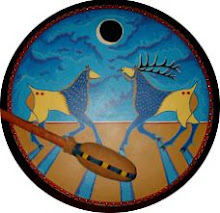Frusta Crow - 1880 -
Un artwork di Angela Swedberg
Fra molti popoli Nativi, e specialmente nel Nord Ovest del Paese, era
diffuso l'utilizzo di un particolare tipo di frusta detta in inglese
Antler quirt. Essa era ricavata dal corno di un cervo che era prima
lucidato e poi lentamente inciso secondo una tecnica che sarebbe stata
detta solo successivamente Scrimshaw. La tecnica prevedeva di realizzare
i motivi scelti praticando delle incisioni di pochi millimetri e di poi
riempire le stesse con del materiale colorante misto a colla animale o
grassi, in modo da far meglio risaltare il disegno.
Nel Plateau, ma
anche frai Crow, era poi uso comune quello di aggiungere una fascia in
pelle riccamente decorata al fine di meglio impugnare l'attrezzo ed
ottenere un effetto maggiore.
I Nativi generalmente non usavano la
frusta per colpire il cavallo, quanto piuttosto per farla schioccare in
aria per incitarlo, ma qualunque fosse l'utilizzo essa era un forte
indicatore dello status sociale del suo proprietario. E per questo per
realizzarla erano usati materiali pregiati e lo stesso corno per una
buona frusta doveva provenire solo da quella specie particolarmente
imponente di cervo che i bianchi avrebbero poi chiamato Washington deer. Questa a seguire è una frusta su cui sto lavorando.
--------------------------------------------
Among many Native peoples, and especially in the North West of the country, was common a particular type of whip known as Antler quirt. It was made from the horn of a deer that was first polished and then slowly etched according to a technique that would be known only later as Scrimshaw. The technique involved to realize the motifs by practicing a few millimeters incisions and then to fill it with coloring material mixed with animal glue or grease, to better highlight the design.
In the Plateau, but also among the Crow, was also common to add a beaded leather band in order to better grasp the whip and get a stronger effect.
Natives generally did not use the whip to hit the horse, but rather to make it pop up in the air to encourage the horse, but whatever was the use it was a strong indicator of the social status of its owner. And for this high-quality materials were used and the same horn for a good whip should only come from a particularly impressive deer species that whites would then called Washington deer. This is an antler quirt I'm still working on.


